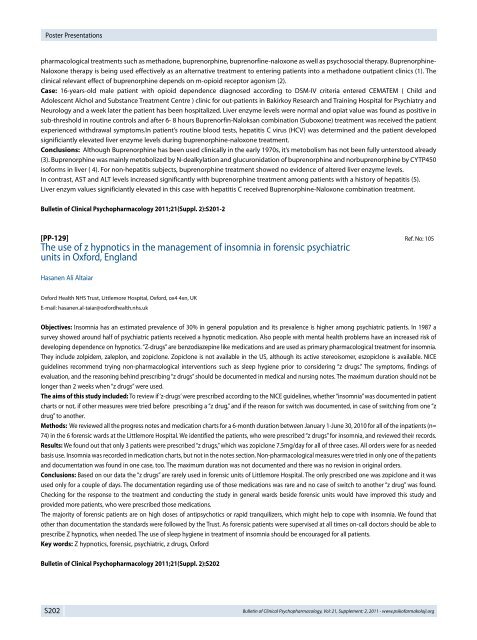SYMPOSIA
SYMPOSIA
SYMPOSIA
Create successful ePaper yourself
Turn your PDF publications into a flip-book with our unique Google optimized e-Paper software.
Poster Presentations<br />
pharmacological treatments such as methadone, buprenorphine, buprenorfine-naloxone as well as psychosocial therapy. Buprenorphine-<br />
Naloxone therapy is being used effectively as an alternative treatment to entering patients into a methadone outpatient clinics (1). The<br />
clinical relevant effect of buprenorphine depends on m-opioid receptor agonism (2).<br />
Case: 16-years-old male patient with opioid dependence diagnosed according to DSM-IV criteria entered CEMATEM ( Child and<br />
Adolescent Alchol and Substance Treatment Centre ) clinic for out-patients in Bakirkoy Research and Training Hospital for Psychiatry and<br />
Neurology and a week later the patient has been hospitalized. Liver enzyme levels were normal and opiat value was found as positive in<br />
sub-threshold in routine controls and after 6- 8 hours Buprenorfin-Naloksan combination (Suboxone) treatment was received the patient<br />
experienced withdrawal symptoms.In patient’s routine blood tests, hepatitis C virus (HCV) was determined and the patient developed<br />
significiantly elevated liver enzyme levels during buprenorphine-naloxone treatment.<br />
Conclusions: Although Buprenorphine has been used clinically in the early 1970s, it’s metobolism has not been fully unterstood already<br />
(3). Buprenorphine was mainly metobolized by N-dealkylation and glucuronidation of buprenorphine and norbuprenorphine by CYTP450<br />
isoforms in liver ( 4). For non-hepatitis subjects, buprenorphine treatment showed no evidence of altered liver enzyme levels.<br />
In contrast, AST and ALT levels increased significantly with buprenorphine treatment among patients with a history of hepatitis (5).<br />
Liver enzym values significiantly elevated in this case with hepatitis C received Buprenorphine-Naloxone combination treatment.<br />
Bulletin of Clinical Psychopharmacology 2011;21(Suppl. 2):S201-2<br />
[PP-129] Ref. No: 105<br />
The use of z hypnotics in the management of insomnia in forensic psychiatric<br />
units in Oxford, England<br />
Hasanen Ali Altaiar<br />
Oxford Health NHS Trust, Littlemore Hospital, Oxford, ox4 4xn, UK<br />
E-mail: hasanen.al-taiar@oxfordhealth.nhs.uk<br />
Objectives: Insomnia has an estimated prevalence of 30% in general population and its prevalence is higher among psychiatric patients. In 1987 a<br />
survey showed around half of psychiatric patients received a hypnotic medication. Also people with mental health problems have an increased risk of<br />
developing dependence on hypnotics. “Z-drugs” are benzodiazepine like medications and are used as primary pharmacological treatment for insomnia.<br />
They include zolpidem, zaleplon, and zopiclone. Zopiclone is not available in the US, although its active stereoisomer, eszopiclone is available. NICE<br />
guidelines recommend trying non-pharmacological interventions such as sleep hygiene prior to considering “z drugs.” The symptoms, findings of<br />
evaluation, and the reasoning behind prescribing “z drugs” should be documented in medical and nursing notes. The maximum duration should not be<br />
longer than 2 weeks when “z drugs” were used.<br />
The aims of this study included: To review if ‘z-drugs’ were prescribed according to the NICE guidelines, whether “insomnia” was documented in patient<br />
charts or not, if other measures were tried before prescribing a “z drug,” and if the reason for switch was documented, in case of switching from one “z<br />
drug” to another.<br />
Methods: We reviewed all the progress notes and medication charts for a 6-month duration between January 1-June 30, 2010 for all of the inpatients (n=<br />
74) in the 6 forensic wards at the Littlemore Hospital. We identified the patients, who were prescribed “z drugs” for insomnia, and reviewed their records.<br />
Results: We found out that only 3 patients were prescribed “z drugs,” which was zopiclone 7.5mg/day for all of three cases. All orders were for as needed<br />
basis use. Insomnia was recorded in medication charts, but not in the notes section. Non-pharmacological measures were tried in only one of the patients<br />
and documentation was found in one case, too. The maximum duration was not documented and there was no revision in original orders.<br />
Conclusions: Based on our data the “z drugs” are rarely used in forensic units of Littlemore Hospital. The only prescribed one was zopiclone and it was<br />
used only for a couple of days. The documentation regarding use of those medications was rare and no case of switch to another “z drug” was found.<br />
Checking for the response to the treatment and conducting the study in general wards beside forensic units would have improved this study and<br />
provided more patients, who were prescribed those medications.<br />
The majority of forensic patients are on high doses of antipsychotics or rapid tranquilizers, which might help to cope with insomnia. We found that<br />
other than documentation the standards were followed by the Trust. As forensic patients were supervised at all times on-call doctors should be able to<br />
prescribe Z hypnotics, when needed. The use of sleep hygiene in treatment of insomnia should be encouraged for all patients.<br />
Key words: Z hypnotics, forensic, psychiatric, z drugs, Oxford<br />
Bulletin of Clinical Psychopharmacology 2011;21(Suppl. 2):S202<br />
S202 Bulletin of Clinical Psychopharmacology, Vol: 21, Supplement: 2, 2011 - www.psikofarmakoloji.org



